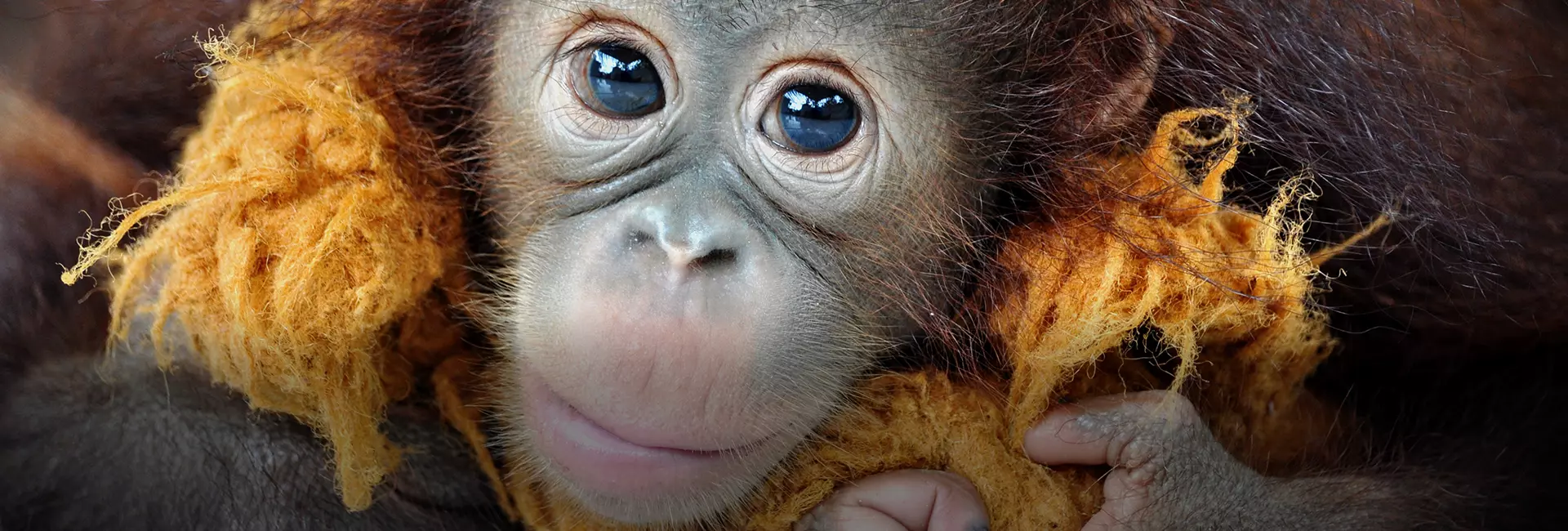We are often asked questions such as "Will I have hands-on contact with the orangutans?" Or "Can I cuddle or play with the babies at the project site?"
The simple answer to this is, and will always be, no. Whilst we realise this may be a disappointing answer to hear, hopefully after reading this article you will understand why this is such a crucial policy in continuing the hard work our projects and our project partners do for orangutan conservation. The three main reasons why human-orangutan contact is prohibited for volunteers are:
1. The Risk of Infection
The risk of a human passing a disease to one of our primate cousins is very real. As these great apes are genetically very similar to us (sharing 97% of our DNA), they can suffer from any illness or disease we can and they often prove to be a lot more dangerous for orangutans than they are for humans. A common cold, for example, could harm a baby orangutan irreparably which is why volunteers always observe them from a safe distance whilst wearing facemasks.
More often than not at the rehabilitation and rescue centres, young orangutans are brought in after they have been orphaned at a very early age. Not only do disease and infection carry more risk for younger primates, but as these orphaned orangutans would have been deprived of the nutrients and benefits of their mother's milk, they almost always have weaker immune systems than other similar-aged wild orangutans. Any exposure to germs that are common for humans, may prove fatal to these underdeveloped babies. This is why it is crucial that the young orangutans in particular are looked after in a controlled way and not introduced to a large number of new people.
Infections and diseases may also cease the possibility of releasing an adult orangutan back into the wild. If any animal has been exposed to a disease that is not found in its natural habitat, releasing the animal could potentially decimate a healthy wild population and so would not be permitted.

2. Habituation and Behavioural Changes
Much like a human child, having new caregivers frequently coming in and out of their lives would be unsettling and potentially distressing for a young orangutan. The ultimate goal of the sanctuaries is to rehabilitate and release as many orangutans as possible back into the wild, and for this to happen, they need consistency.
Behavioural problems are also likely to arise if the young orangutans’ routines are consistently disrupted. A revolving door of people directly involved in their care is not only detrimental to their well-being but also humanises them to a point where they believe all humans to be approachable. This could make them more susceptible to poaching or human-wildlife conflict if they are released back into the wild.
The surrogate mothers at the sanctuary are therefore kept to a minimum and are all specially trained long-term local staff. Not only does this decrease the risk of infection as previously mentioned, but it allows the orangutans to feel safe and comfortable, surrounded by a permanent group of staff who live on-site and will be in the animal's life in the long term.

3. The Risk to Humans
Due to their inherent ability to look cute, cuddly and playful almost all of the time, people assume that they would be able to interact with an orangutan and play with them in a similar way they would with a household pet. This, however, isn’t true, and whilst they may look similar to humans in size and build, our arboreal cousins are up to seven times stronger than the average man. Even after years at a rehabilitation centre, animals will always have their natural instincts to protect themselves and if they were to feel threatened, they could do an incredible amount of damage. Even playful curiosity may go too far as orangutans often do not know their own strength.
For your safety and that of the animals, this is another reason why contact is prohibited. Additionally, should an orangutan injure a volunteer, the orangutan may have to be put down in fear that they are an aggressive animal, and this would be as a result of unnecessary human contact - having no contact with the orangutans completely eliminates this possibility.
How Volunteers Aid Orangutan Conservation Whilst Remaining Hands-Off
The no-contact policy often comes as a bit of a reality check for people wanting to volunteer with orangutans. This is the difference between a tourist and a volunteer. Whilst a tourist may, albeit unintentionally, see no harm in playing with or touching an orangutan at one of the sanctuaries, a volunteer knows why this is a damaging thing to do. The orangutans at the sanctuaries are there to heal, to be rehabilitated and released, all while helping restore the critically endangered species to its former numbers in the wild. As a volunteer, you will help with activities such as enrichment, food preparation, construction, reforestation and more that are crucial in helping the sanctuaries in their collective aim of releasing as many orangutans back into the wild as possible. All the while, you’ll be in close proximity to the orangutans and receive a behind-the-scenes view of a successful sanctuary that is making a real difference to orangutan conservation. Take a look at the video below to see what you could experience when you volunteer with orangutans:

















